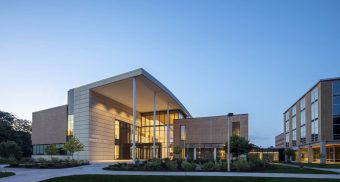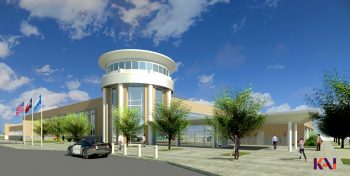October 08, 2019 Project of the Week

Project Name: City of Kirkland Culvert Replacement
Company Name: Stantec
Project Location: Kirkland, Washington United States
Project Information/Details: Stantec—a global engineering, architecture, and consulting firm—is helping the City of Kirkland improve fish passage and reduce flooding in Cedar Creek by replacing an aging culvert at 100th Avenue Northeast. The design team recently submitted a 30-percent design to the U.S. Army Corps of Engineers for permitting on the $1 million project. “By working with the City of Kirkland we have an opportunity to restore a key stretch of Cedar Creek,” said Jim McPherson, Stantec project manager, based in Bellevue. “The project will bring back a more natural channel and provide a longer path for flow than currently exists. That will allow natural vegetation to come back. Supporting aquatic habitat is a priority within the community and within the state. This project supports that goal, providing the best return on investment to the City of Kirkland.” Stantec’s role is to help the City design and build the new culvert in a way that minimizes the work’s effect on traffic flow. The City of Kirkland is planning to begin construction next summer on the culvert. The original Cedar Creek 36-inch concrete box culvert is structurally degraded and the size and orientation of the culvert blocks fish passage. The downstream channel is eroded from high flow events and high-water velocity due to the culvert conditions. Upstream, the storm-detention structure is outdated and does not provide adequate flow control, prevents sediment transport, and limits the natural function of the upstream habitat. This project will resolve these issues, opening habitat for salmonids and other fish species and will reduce the risk of flooding in the community. “This project is important for the health of our streams and all of the species that depend on them,” said Kirkland Project Engineer Laura Drake. “It’s also a vital component of the 100th Avenue Northeast Corridor, one of Kirkland’s three north-to-south corridors. We are happy to have Stantec to guide us through the process of improving it.” Stantec is providing project management, civil design, biological design, structural design; and environmental permitting, mitigation and restoration design. Stantec’s local team of engineering and environmental experts includes more than 350 professionals. The firm has completed more than 85 fish-passage projects in Washington and Oregon. The project is expected to be completed in October 2020. About Stantec Communities are fundamental. Whether around the corner or across the globe, they provide a foundation, a sense of place and of belonging. That’s why at Stantec, we always design with community in mind. We care about the communities we serve—because they’re our communities too. This allows us to assess what’s needed and connect our expertise, to appreciate nuances and envision what’s never been considered, to bring together diverse perspectives so we can collaborate toward a shared success. We’re designers, engineers, scientists, and project managers, innovating together at the intersection of community, creativity, and client relationships. Balancing these priorities results in projects that advance the quality of life in communities across the globe
Project of the Week

Project Name: Edward J. Minskoff Pavilion
Company Name: LMN Architects
Project Location: East Lansing, Michigan United States
Project Information/Details: LMN Architects is pleased to celebrate the opening of the new Edward J. Minskoff Pavilion at Michigan State University on September 27th, 2019. The building combines state-of-the-art teaching facilities with social spaces and establishes a new front door for the Broad College of Business. The Edward J. Minskoff Pavilion at Michigan State University transforms the Eli Broad College of Business into a unified complex at the forefront of business education. The three-story, 100,000-square-foot structure combines modern teaching facilities with contemporary social spaces, creating a socially active learning environment for students, faculty, corporate partners, and alumni to collaborate in forming future generations of business leaders. Technology integration, classrooms, and flexible spaces promote academic and professional excellence, uniquely suited to problem solving in today’s global marketplace. Sanjay Gupta, Eli and Edythe L. Broad Dean, comments: “The Minskoff Pavilion is unlike any other project the university has seen and represents the next phase of higher education. We placed an intentional emphasis on the pavilion’s architecture and classroom designs to enhance the experience that each student will have and it has been a pleasure working with LMN Architects to accomplish this. Broad Spartans have a new building on campus to call home where they can unleash their creativity and benefit from a space that is focused on collaboration and teamwork.” Rafael Viñoly-Menendez, Design Partner, comments: “From our first conversations on the project, Dean Gupta expressed a clear vision for the building: a place that would not only foster learning, collaboration, and engagement with alumni and the business community, but also a facility that would weave the existing spaces to create a more cohesive “campus within a campus.” He was equally inspired by the opportunity to connect the interior spaces to nature as an essential element of the students’ well-being. And above all, the building needed to welcome all students, and not be perceived as exclusively a benefit to the business school.” Located within the heart of the university along the Red Cedar River, the massing and geometry of the building complete the sequence of spaces in the college’s existing facilities while creating a new connection to the river walk. A riparian meadow is designed to both manage storm water and reestablish a natural habitat along the Red Cedar River. Inspired by Broad College’s team-based community culture, the design weaves together classrooms, team rooms, and social spaces at a variety of scales. These program elements permeate all aspects of the academic experience, with an emphasis on collaborative environments supporting the college’s cutting-edge research curriculum. Robert Smith, Principal, comments: “We worked with the college to complete the existing complex instead of just creating an addition. This meant clear circulation routes that tied all of their buildings together and providing lounge, food service, team work, and event spaces that were missing from the existing buildings. These amenities are already having a dramatic impact on the amount of time students spend in the building – which directly improves social performance and goal attainment.” A central communal atrium is framed by two program “bars” that focus views through the building to the river and landscape beyond. Classrooms, student services and administrative spaces are dispersed through all levels and are arranged around this central social space. Skylights and clerestory windows along the length of the atrium fill the space with natural light and encourage continuous student use for independent study, group projects, and informal meetings. Rafael Viñoly-Menendez, Design Partner, comments: “The atrium was designed to be the ‘heart’ of the Broad College of Business, the place where students can gather, as individuals and a community, to share experiences. At the campus level, it connects Shaw Lane and the College of Law visually to the river, reinforcing MSU’s foundational connection to nature as a Land Grant institution.” The atrium celebrates a sense of arrival, providing a new hub for Broad College to host college-wide events, recruitment fairs, informal gatherings, and team collaboration. Circulation balconies overlooking the atrium lead to flat/flexible and tiered/case study classrooms for face-to-face discussions, technology-enabled active learning, and networking. A central feature of the atrium are generous amphitheater stairs, navigating a one-story descent from the main entry down to the ground floor, which houses the café, student lounge, team rooms, garden courtyard, and a terrace with seating steps, opening to the river. The pavilion’s masonry, glass, and metal exterior express the contemporary functionality of its forward-looking programs while complementing the materials and sensibility of the surrounding campus architecture. Rafael Viñoly-Menendez, Design Partner, comments: “Working within an Integrated Project Delivery framework, our team of LMN, FTCH, OLIN and Clark Construction collaborated with MSU’s Infrastructure Planning and Facilities staff to successfully deliver Dean Gupta’s vision for the new building. Fundamentally for us, the goal was to design a facility that fosters collaboration, connection and shared discoveries. The Minskoff Pavilion will hopefully play its part in the social experience of generations of future Spartans.” LMN Architects is a leader in the design of higher education facilities across the United States. Other completed projects include the Bill & Melinda Gates Center for Computer Science & Engineering at the University of Washington; the Voxman Music Building at the University of Iowa in Iowa City; the Anteater Learning Pavilion at the University of California, Irvine; and the Huntsman School of Business Addition at Utah State University in Logan, Utah. About LMN Architects Since its founding in 1979, LMN Architects has dedicated its practice to the health and vitality of communities of all scales. Internationally recognized for the planning and design of environments that elevate the social experience, the firm works across a diversity of project typologies, including higher education facilities, science and technology, civic and cultural projects, conference and convention centers, urban mixed-use and transportation. LMN has successfully completed over 700 projects across North America, including the Voxman Music Building at the University of Iowa in Iowa City, Iowa; Tobin Center for the Performing Arts in San Antonio, Texas; Vancouver Convention Centre West in Vancouver, Canada; Sound Transit University of Washington Station in Seattle, Washington; and the new Hyatt Regency in Downtown Seattle. Based in Seattle, Washington, LMN Architects is led by partners John Chau, Sam Miller, Walt Niehoff, Wendy Pautz, Mark Reddington, George Shaw, Stephen Van Dyck, and Rafael Viñoly-Menendez. The firm employs 150 talented professionals practicing architecture, interior design, and urban design, and the quality of the work has been recognized with nearly 300 national and international design awards, including the prestigious 2016 National Architecture Firm Award from the American Institute of Architects (AIA).
September 24, 2019 Project of the Week

Project Name: Dallas County South Government Center
Company Name: KAI Design
Project Location: Dallas, Texas United States
Project Information/Details: Construction got underway on a new 73,000-square-foot Dallas County South Government Center (DCSGC) at the southern edge of Dallas County at Interstate 20 and South Polk Street. KAI Design served as the Architect-of-Record on the project, plus integrated its in-house MEP engineering group into the project and assisted with master planning the overall site for future growth. The new two-story building will replace and consolidate three existing aging facilities under one roof and will house Dallas County’s Tax Office; County Constable; Sheriff’s Traffic Division, Dispatch and K-9 Unit; and two Justice of the Peace courts. Design features of the new facility include a public walking trail around the property that will also be used by the Constable’s and Sheriff’s Academy for agility training, food truck parking adjacent to the detention pond, a weight room for the employees and a wellness room for nursing mothers. The project also included the design and integration of a 160-foot-tall radio communications tower, a kennel for the K-9 Unit, and property and evidence storage for the Sheriff’s Traffic Division. The Sheriff’s dispatch area has been designed as an ICC-500 2015 Storm Shelter that will withstand winds of up to 200 MPH and remain operational during severe weather. This facility will also serve as a back-up dispatch center for adjacent municipalities. “We leveraged our storm shelter design experience and worked collaboratively with our structural engineering consultant to bring forth an innovative design,” said Derwin Broughton, AIA, NCARB, Principal – Business Development at KAI. The facility is designed to achieve a LEED v4 Silver Certification. Construction of the facility is expected to be completed in December 2020. About KAI Enterprises KAI Enterprises is a national design and build firm providing delivery-oriented building solutions with a diverse portfolio of experience, in-house multi-discipline professionals, and expertise in both design and construction delivery. Founded in 1980, KAI has grown into one of the largest minority-owned firms in the AEC industry. For nearly 40 years, KAI has been instrumental in transforming communities through its expertise in residential, commercial, K-12, higher education, healthcare, science and technology, aviation, mobility, sports and entertainment, government, water and community-focused projects. KAI Enterprises is comprised of four distinct business units—KAI Design, KAI Engineering, KAI Build and KAI 360 Construction Services. To learn more about KAI, visit www.kai-db.com.


